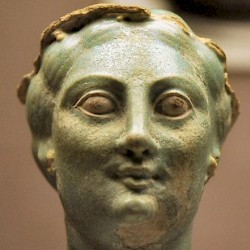Jona Lendering
Jona Lendering read history at Leiden University (MA 1993), specialized in Mediterranean culture at the Amsterdam Free University (MA 1996), and worked at excavations in Holland (Riethoven) and Greece (Halos). After teaching historical theory and ancient history at the Free University for several years, he was one of the founders of a school for history teaching, Livius Onderwijs. Born in Amsterdam, it has now spread to auxiliary locations in Bussum, Dronten, Gouda, Haarlem, Hoorn, Schagen, Zaanstad, and Zoetermeer. As of 2013, Livius Onderwijs has eight teachers, about 500-600 students a year, and offers tours to countries like Italy, Turkey, Iran, and Lebanon. The field trips help to etch into the students' minds some of what they've learned at the school.
Because history is for a large part telling a story, something you do best in your own language, Lendering prefers to publish in Dutch journals. However, he has contributed to the Bryn Mawr Classical Review and Ancient Warfare, while he is the founder of Ancient History Magazine. He is also the publisher and editor of the on-line publication of the Babylonian Chronicles of the Hellenistic Period, a set of important cuneiform sources for the history of the Seleucid and Parthian Near East, transcribed, translated and commented on by Bert van der Spek of the Free University Amsterdam and Irving Finkel of the British Museum. A publication as book is in preparation.
Lendering has written several books and maintains a blog in Dutch. He is the author of several books, including Edge of Empire and Consensus and Crises. For the Livius website, which has received several awards, he collaborates closely with Bill Thayer of LacusCurtius. Lendering is also the webmaster of two daily blogs, the MainzerBeobachter.com and Grondslagen.net.
There are 9380 items in Jona Lendering:
Arsaces XV, Orodes I
Arsaces XV, Orodes I: Arsacid king during a brief "dark period" in the history of the Parthian Empire (r.80/79-75). Orodes I After the long…Arsaces XVI
Arsaces XVI: little-known Arsacid king during a brief "dark period" in the history of the Parthian Empire (r.75-62/61). A Parthian After the long and…Arsaces XVII, Phraates III
Arsaces XVII, Phraates III: Arsacid king of the Parthian Empire (r.70/69-58/57). Phraates III The Parthian "dark age", a confused period that lasted some…Arsaces XVIII, Mithradates IV
Arsaces XVIII, Mithradates IV: Arsacid king of the Parthian Empire (r.58/57-54). Mithradates IV After a generation of confusion, known as the "dark age" of…Arsacids
TheParthian or Arsacid Empire was the most enduring of the empires of the ancient Near East. After the Parni nomads had settled in Parthia and had built a small independent kingdom, they rose to power under king Mithradates the Great…Arsacids of Armenia
Arsacids of Armenia: name of a dynasty of kings, ruling in Armenia since the mid-first century. It was a branch of the Arsacid dynasty in the Parthian Empire.According to a treaty, concluded in 20 BCE between the Roman ruler Augustus…Arsameia on the Nymphaios
Arsamaeia on the Nymphaios: residence of the kings of Commagene, tomb of king Mithridates I Callinicus (r.109-70 BCE). The site is now known as Eski Kale, "the old castle". …Arsames
Arsames (Old Persian: Aršâma): name of the grandfather of the Persian king Darius I the Great. He must have lived in the mid-sixth century BCE.Arsames is mentioned in the prologue of the Behistun Inscription, in which its author, Darius the Great,…Arsames of Armenia
Arsames (Greek:᾽Αρσάμης): Orontid king in Armenia (r. c.240 BCE)King Arsames, who ruled (part of) Armenia, is known from the inscriptions, found on Nemrud Dagi, in which king Antiochus I Theos of Commagene mentions his ancestors. Arsames must be dated in the…Arsinoe I
Arsinoe I: first wife of Ptolemy II Philadelphus, queen in the Ptolemaic Empire.Relatives: Father: Lysimachus Mother: Nicaea Husband: Ptolemy II Philadelphus Son: Ptolemy 'the son', Ptolemy III Euergetes, Lysimachus, Berenice Phernephorus (married to Antiochus II Theos) Main deeds: c.285: Marriage between Arsinoe I and Ptolemy II…Arsinoe II
Arsinoe II (c.316-268): second wife of Ptolemy II Philadelphus, queen in the Ptolemaic Empire.Relatives Arsinoe II Father: Ptolemy I Soter Mother: Berenice I First…

Arsinoe II |